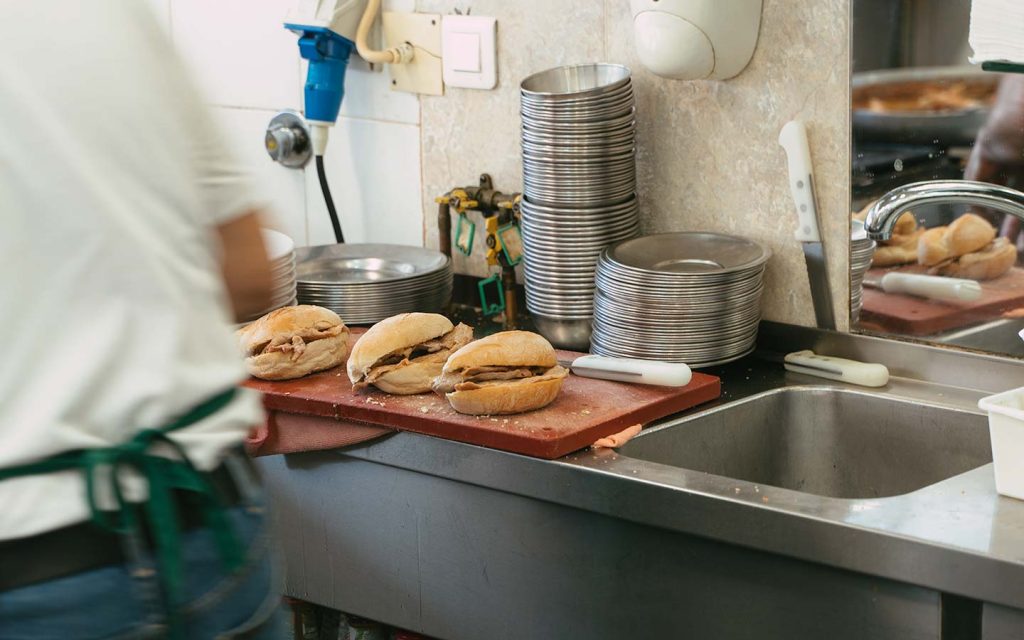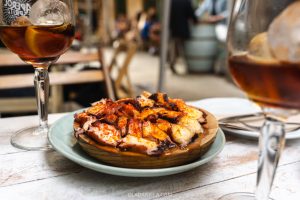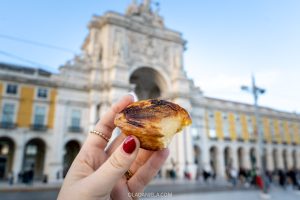Updated Apr 27, 2025
There’s nothing more comforting than knowing you can get a snack at any hour. From hot sandwiches like bifanas and pregos, to petiscos (tapas) of snails and prawns and an overwhelming range of eggy treats, Lisbon is not short of snacks. Hell, there’s even an entire 5pm meal, dedicated to hoeing down a sweet treat and maybe a bica (espresso) to get you from lunch to dinner.
Street food says a lot about culture, and while Portugal’s cities don’t compete with Bangkok or Mexico City on the savoury front, it is easy to find delicious salty or sweet snacks if you know where to look.
Here’s a dozen or so of the best simple Portuguese street foods and snacks that you can hunt out in Lisbon (and across much of Portugal).
Love food? Me too. After this, read my guide to Lisbon’s best restaurants, join one of these top cooking classes, or learn to make pastel de nata with a baking class.

But first, let me introduce you to lanche…
How do the Portuguese eat dinner so late? The answer is lanche. Falling around 5pm each day, this almost-official fourth meal usually leans on the sweet side. You’ll see families lined up outside gelato shops, and if you time it wrong you’ll be queuing at the local pasteleria (pastry shop/bakery). Indeed, my local artisan gelato shop caters predominantly to this crowd and not the after dinner ice cream eaters like yours truly.
Anyway, let’s dive into the best Portuguese street food and snacks to try in Lisbon.
>> Let a local to you show you Lisbon’s best street food on a top-rated food tour >>
– Taste the traditions of Lisbon with Devour’s half-day street food tour
– Go seriously deep into Lisbon’s food scene with Culinary Backstreets’ all-day food tours
– or Oh! My Cod’s original four-hour jaunt that tastes 17 different items!
Read next: Guide to the best food tours in Lisbon
Contents
ToggleSavoury street food and snacks
Tosta mista (toasted ham and cheese sandwich)
Like a friend you can always rely on, the tosta mista is there for you. When in doubt, ask for this ham and cheese toasted sandwich painted with butter at cafes and bakeries. If they offer the Alentejo bread, accept – it’s huge and one will feed two. At the best spots they top it with oregano.
Where to eat a tosta mista: wherever, whenever.
Expect to pay €2.50-5
Bifana (pork sandwich)
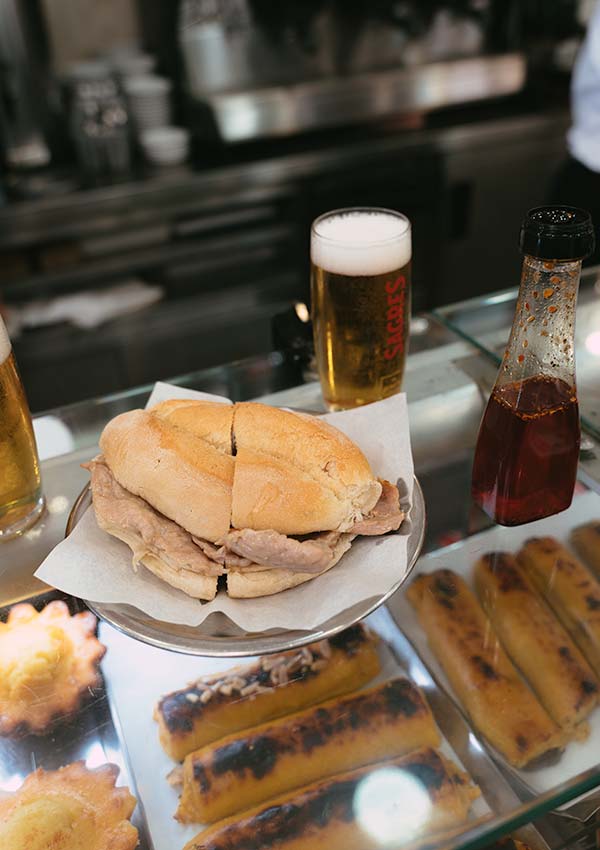
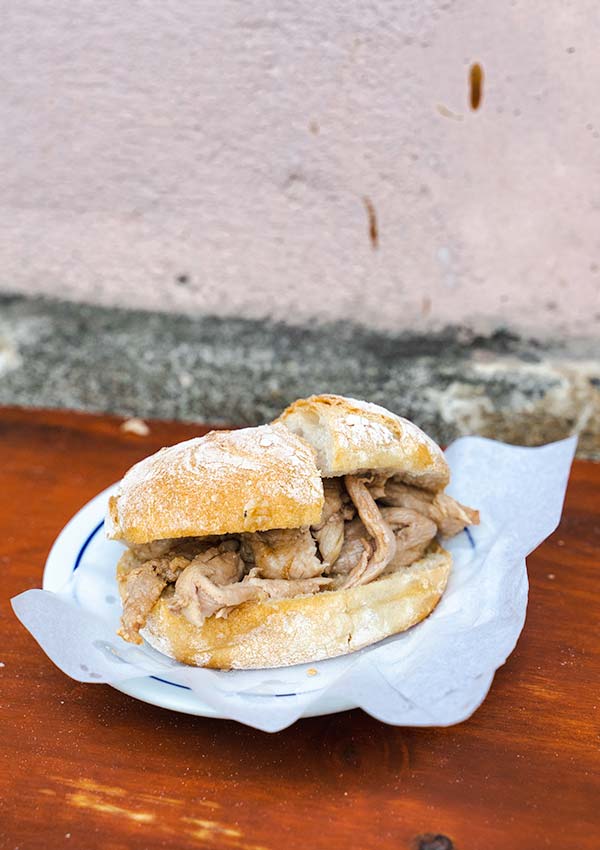
This pork sandwich looks different depending on where you eat it. In Porto and Vendas Novas, they stew pork steaks in a deliciously fatty, flavoursome and slightly spicy broth and the bread soaks up some of the goodness.
In Lisbon, you’ll more likely find thin pork steaks grilled over charcoal with garlic. It’s literally meat in bread, but there’s always DIY condiments. The Portuguese add mustard, but I prefer mayonnaise and piri piri hot sauce.
Where to eat a stewed bifana in Lisbon: As Bifanas do Alfonso
Where to eat a grilled bifana in Lisbon: Any street fair or carnival you’ll find this food
Expect to pay €3-4
Read next: Where to eat in Lisbon: Best restaurants and tascas
Prego (steak sandwich)

A cousin of the bifana, a prego is simply a thin beef steak grilled with garlic and whacked in a bread roll. Strangely, this sandwich is considered dessert at marisqueiras, which are seafood restaurants where you gorge yourself silly on prawns and shellfish.
While it’s usually a thin minute-steak, I’ve started to see fancier spots offer more expensive pregos with fatter, tender steaks that arrive medium-rare.
Where to eat a prego: Rui dos Pregos at the Alcântara Docas is always a good vibe despite being a small chain, Ramiro after seafood, Lutador or any street festa.
Expect to pay €3-8+ (at fancy spots)
Read next: The best cooking classes in Lisbon
Salgados (salty fried treats)
When you enter a bakery or traditional cafe-bar you’ll encounter a counter filled with deep-fried things, usually including (but not limited to) pastéis de bacalhau, rissóis and croquetes.
At an average €1.50 a piece, they’re a cheap and tasty snack to add to your coffee or beer order. The only issue I take with salgados is that they are often cold, having been fried that morning. Thankfully you’ll also find them on the menu at restaurants where you can try them hot.
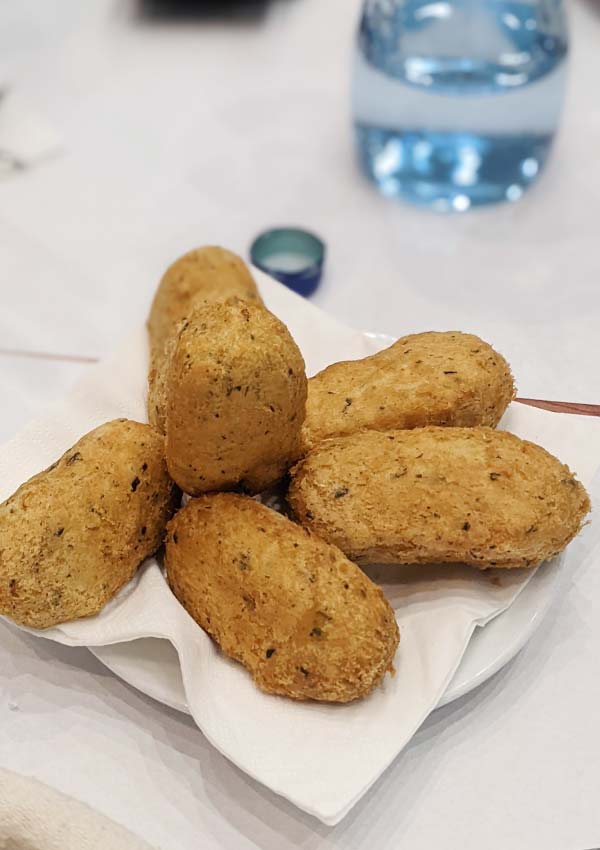
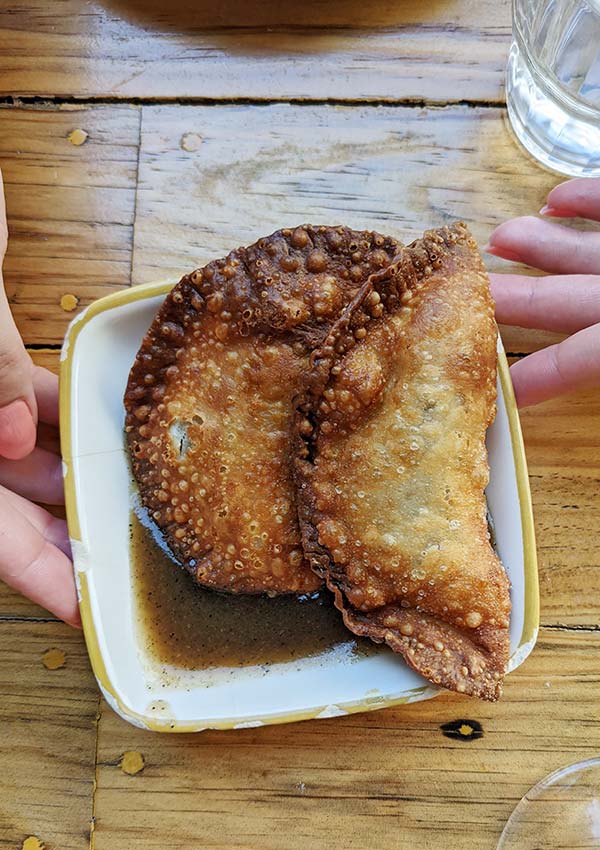
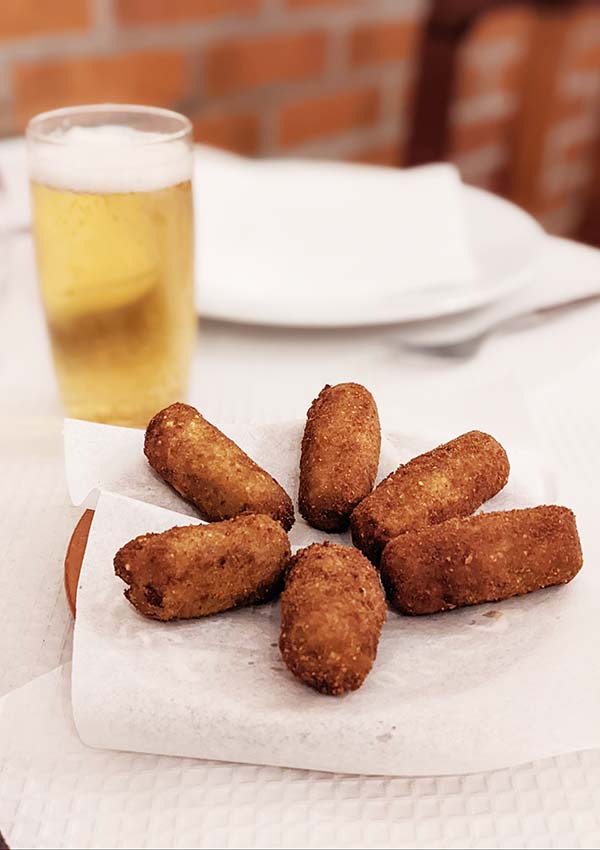
Pastéis de bacalhau: These bacalhau and potato croquettes are a great introduction to the strong flavour of salted cod.
Rissóis: Moon-shaped pastries usually with a prawn or pork filling.
Croquetes: Long cylindrical, crumbed croquettes with a meaty filling.
Where to eat salgados: Pastelarias or cafe bars, or restaurants as a starter. At the more gourmet end, O Velho Eurico is a 10/10.
Expect to pay €1-3
Read next: 25 traditional dishes to order in Portugal
Empadas (small pies)
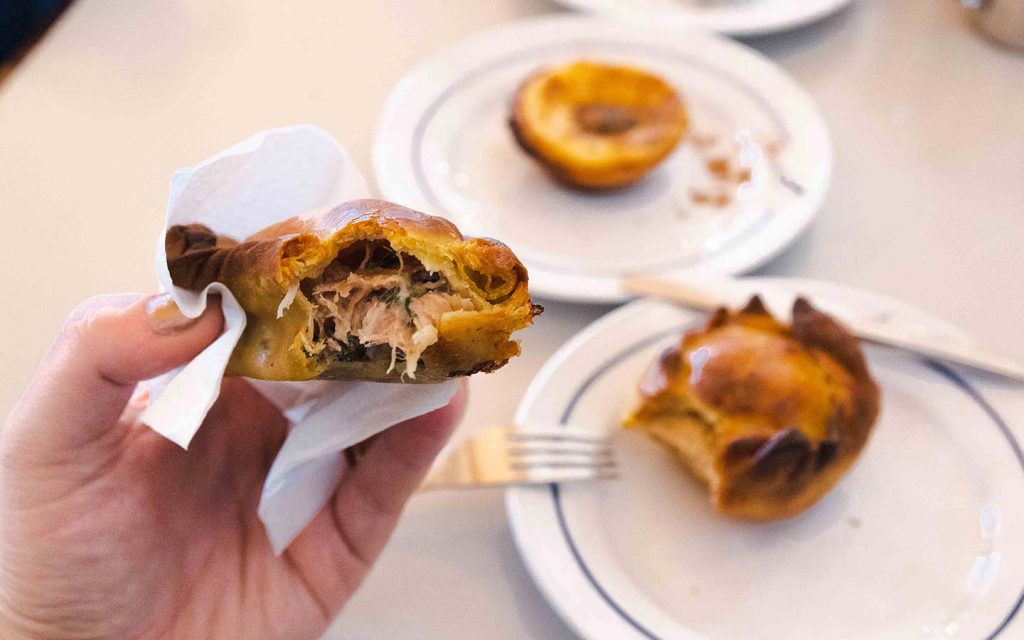
While empadas don’t quite satisfy my love for an Australian meat pie, they are the perfect snack pie and they are almost always good. The mixture is more of a delicious pulled meat than meat and gravy, and I find the most common filling here is chicken. But you can also find vegetarian ones with mushrooms and spinach.
My favourite empada ever is the duck pie at Pastéis de Belem. It’s simply fantastic.
Where to eat empadas: Any pasteleria or cafe, Pastéis de Belem, and Acaso Galveias Quiosque
Expect to pay €2-3
Read next: Where to eat in Belém: the best restaurants, snacks and bars
Sardinhas (sardines)
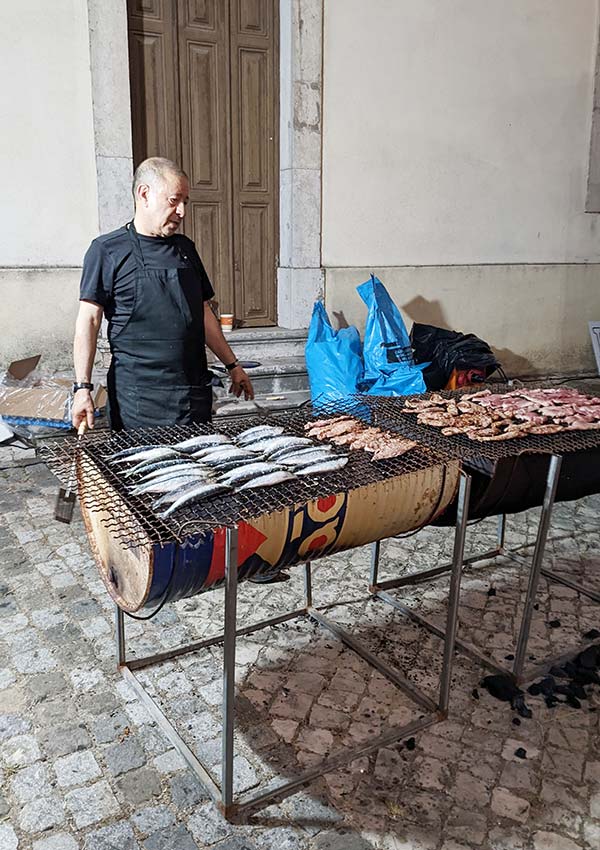
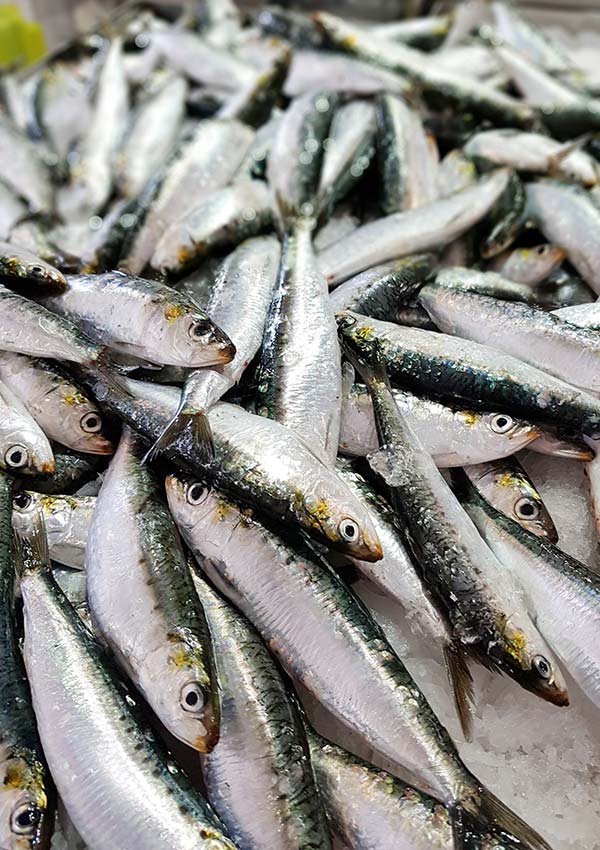
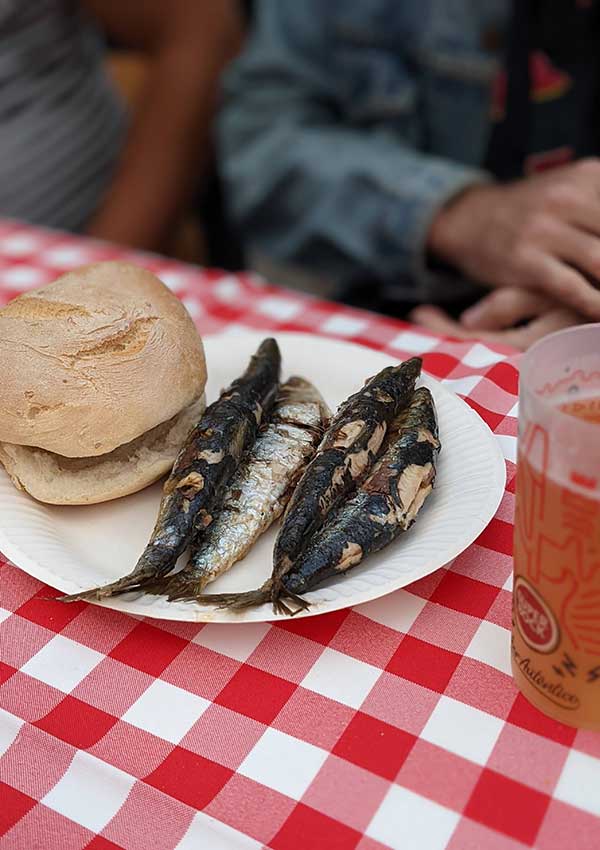
Each June plumes of smoke and pimba music fill the streets of Lisbon’s oldest neighbourhoods. During Santos Populares or Lisbon’s Sardine Festival you’ll find salty, plump sardines lined up like soldiers on the grill, often alongside bifana meat and grilled peppers.
For the entire month of June, street parties take over with pop-up bars, restaurants and barbecues lining the streets. It’s the only time you’ll get sardines grilled like this and served on a single slice of bread. Knock the flesh off each half and enjoy, letting the juices flavour the pão (bread).

Where to eat street sardines: Only during the June parties in Lisbon. The rest of the summer, you can order sardines grilled as a restaurant plate.
Expect to €1.50-€3 per sardine
Tremoços (lupin beans)
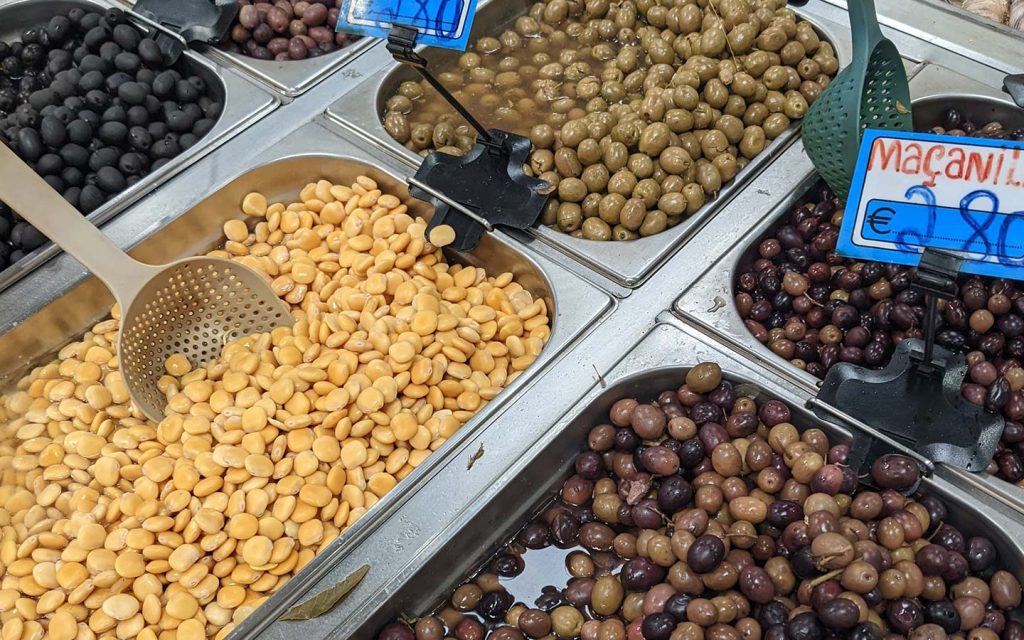
Ever tried lupin beans? I’d never seen them before moving here. These salty little yellow discs often arrive at the table when you order a beer, or you can ask many traditional taverns and bars for them.
They’re stored in brine, but some spots marinate them with garlic and piri piri. To eat them, remove the bean’s outer shell by making a small tear.
Where to eat tremoços: Old-school bars accompanied by a cold beer. Tavern at Casa do Alentejo.
Expect to pay nothing, or maximum €1.50.
Read next: Where to Find the Best Views in Lisbon: 11 Top Miradouros
Petiscos
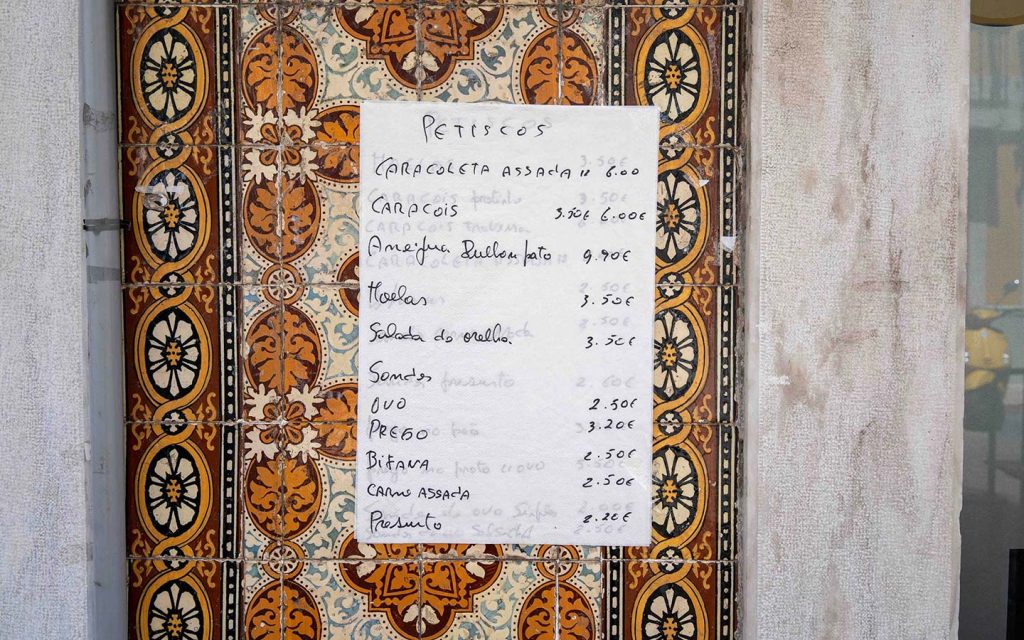
Moving on to a couple of petiscos. That’s the Portuguese version of tapas, or smaller share plates. Ideally you’re sitting on a terrace watching the street life while tucking into a few plates of food with beer and friends on a Lisbon summer evening as the sun starts to set.
Pica pau (steak and pickles)

Chunks of tender steak in gravy with pickles. Pica pau is a delightfully vinegary classic petisco and a favourite dish that’s quite easy to find. Essentially after cooking the slices of steak, the pan is used to make gravy then it’s all served in a pot with pickled carrot and cauliflower. More recently I’ve seen some riffs on the classic done with lightly-seared tuna too.
Where to eat pica pau: Tascas and restaurants. Jorge d’Amalia, Lutador, Pica Pau, Taberna Sal Grosso (tuna)
Expect to pay €8-14
Gambas à guilho (spicy grilled prawns)
Local prawns grilled in olive oil, garlic, booze and piri piri. They’ll arrive at the table sizzling and begging for bread to mop up the juices. You’ll spot this dish as a starter or petisco at many taverns or tascas.
Where to eat gambas à guilho: Ramiro, Príncipe do Calhariz
Expect to pay €8-14
Read next: The Best Pastéis de Nata in Lisbon
Peixinhos da horta (fried green beans)
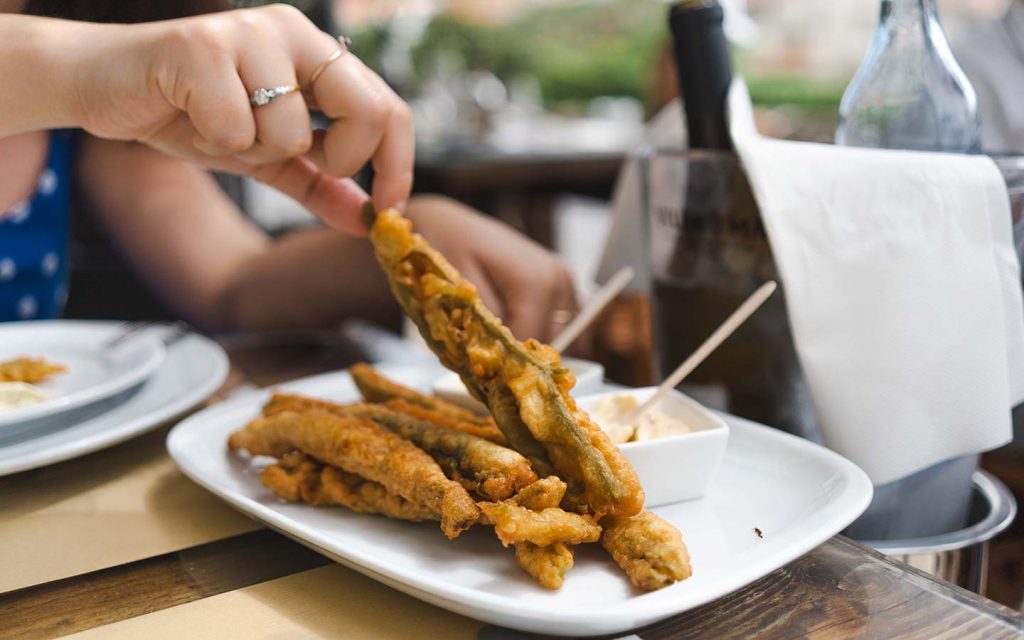
One of Portugal’s few remaining vegetarian dishes, peixinhos da horta are battered and fried green beans. This dish is the original tempura, a technique the Portuguese apparently taught the Japanese who – you could say – perfected it. Meanwhile, Portugal stuck to battering and frying long, flat green beans. This dish of “garden fish” is somewhat tricky to find, but modern petisco bars and diners are bringing it back in vogue as a street food across Lisbon.
Where to find peixinhos da horta: Faz Frio, Pica Pau
Expect to pay €4-8
Queijo (cheese)
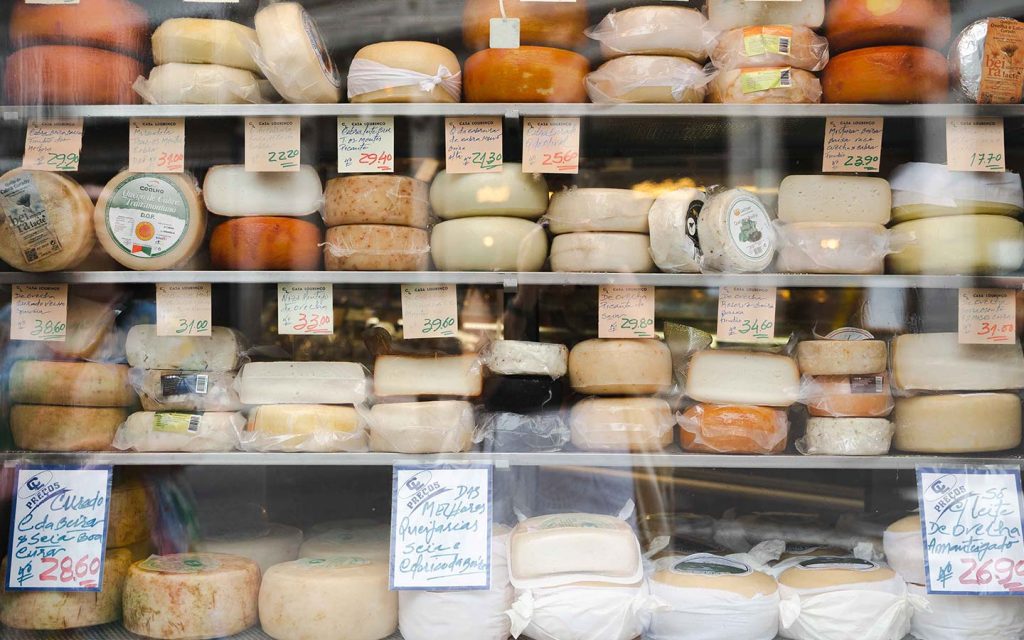
Portugal has a rich cheese culture, and thankfully produces loads of small cheeses that you’ll find in tascas and bars for just a few euros a pop. Most are hugely flavoursome, made with cow, goat or sheep’s milk (or a mix).
A couple to seek out are the orange-hued Nisa, a hard cured cheese, and the Queijo de Azeitão, a creamy and buttery cheese that you cut the top off and eat with a spoon.
Where to find cheese: Cheese is water. You’ll find it almost everywhere you can order a meal. You can find small cheese shops and counters at traditional mercados (markethalls) or try Manteigaria Silva
Expect to pay €3-6
Caracóis (snails)
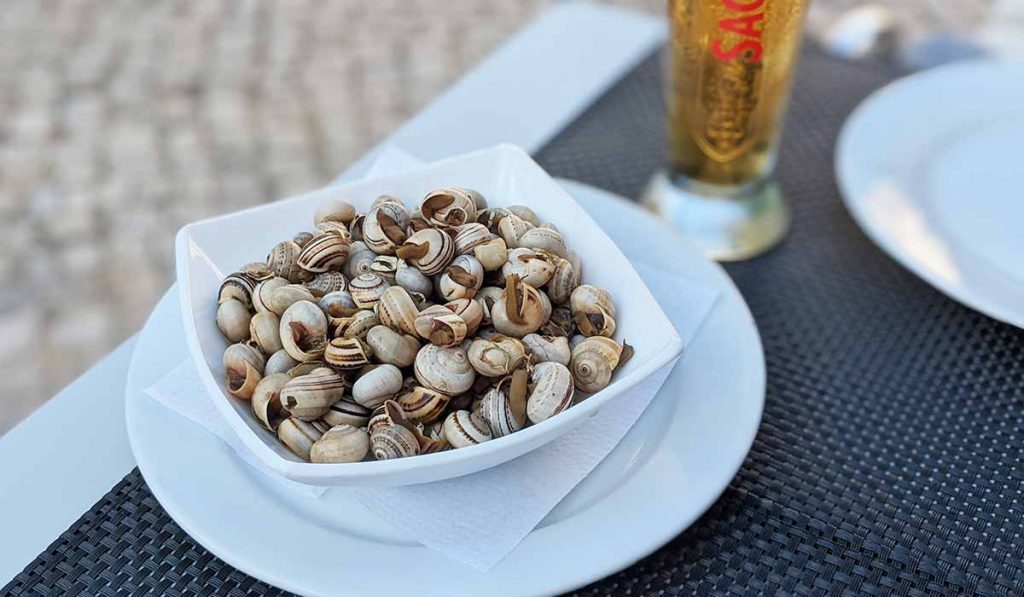
In summer there’s no greater Portuguese street food than snails. Somehow, snails are a post-beach staple, where locals flock to the nearest esplanada (terrace bar) and down beers with a plate of snails after a day in the sun.
Forget what you know about French snails, smothered in garlic and butter. In Portugal they’re much much smaller and you’ll receive a plate with at least 50-100 tiny snails that have stewed in a flavoursome broth with garlic, onion, chilli and oregano.
Where to eat caracois: Casa dos Caracóis, Lutador. Look for tascas with a sign that says “Há caracóis”
Expect to pay €4-8
>>> Experience Lisbon on a 5-star street food tour! Taste the traditions of Lisbon with Devour’s half-day street food tour, or go seriously deep into Lisbon’s food scene with Culinary Backstreets’ all-day food tours, or Oh! My Cod’s original four-hour jaunt that tastes 17 different items!
Pão com chouriço (chorizo bread)
A slice of delicious Portuguese chouriço baked into a fresh bread roll. It’s as simple as that. You can usually find this ready-made snack in pastelerias and on the streets late at night — but more on late-night snacks in Portugal later.
Where to find pão com chouriço: Bakeries, A Merendeira, and Pão com Chouriço de Santo André at the weekend Mercado de Santo André in Colares, Sintra.
Expect to pay €2-3
Castanhas (roasted chestnuts)
When cool autumn breezes are felt in the air, vendors selling castanhas fill the streets, their huge plumes of smoke adding to the atmosphere of the city. Yes, in autumn and winter you’ll spot portable stalls on street corners with castanha sellers yelling “quentes e boas” (hot and good!). It’s one of the only street-side food sellers in Lisbon. The nuts are cooked with salt.
Where to find castanhas: look for the smoke at street corners in autumn
Expect to pay €2-4 for a dozen
Read next… Restaurants open Sunday and Monday in Lisbon
Sweet treats for lanche in Lisbon
Pastel de nata (Portuguese custard tart)
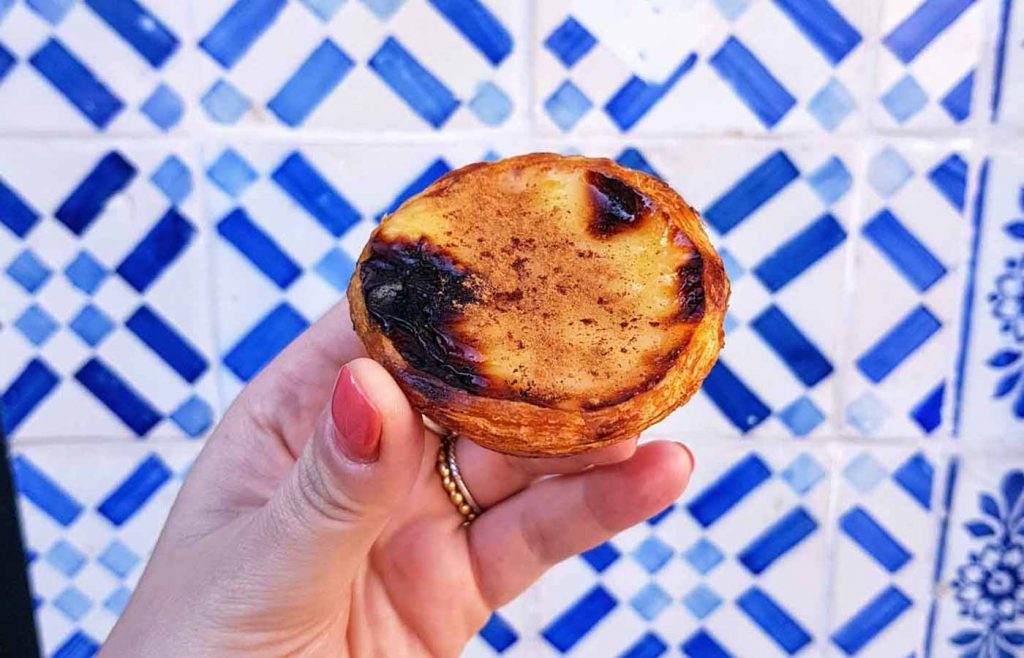
This sweet needs no introduction, surely. While originally from Lisbon, these days you can find pastéis de nata in bakeries and cafes across Portugal – and, indeed, the world. But not everywhere does it well, and I’d argue that it pays to visit the popular spots where turnover is high and freshness is top priority.
Where to find pastéis de natas: Read this blog about where to eat the best pasteis de natas in Lisbon.
Expect to pay €1.10-1.30
Read next: The best pastel de nata cooking classes in Lisbon
Brioche croissant

The French must sigh or die when they spot Portugal’s take on the croissant. While you can often find a semi-decent butter croissant here, the locals love the brioche version. The best are found in Porto, but down in Lisbon you’ll spot it in bakeries where you can eat it as is or order it with ham and cheese jammed into the slightly sweet interior.
Where to find sweet croissants: Bakeries and O Careca.
Expect to pay €1.50-2
Pão de Deus
“Bread of god” has a dramatic ring to it, that’s for sure. This sweet bun is topped with a sweet coconut spread, and while they’re good solo you can eat ‘em jammed with ham and cheese too, nailing that salty-sweet combo.
Where to find pão de Deus: Bakeries. Best spot is Confeitaria Nacional.
Expect to pay €2-3
Bolas de Berlim (Berliner or filled doughnut)
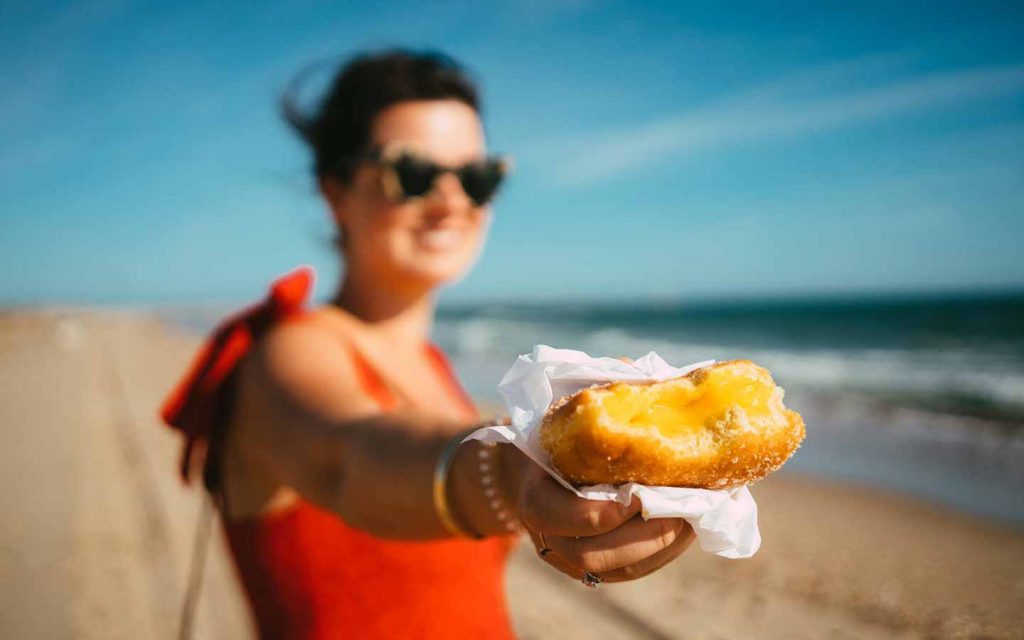
Lie on any Portuguese beach in the summer months and no doubt you’ll hear the cries: “Olha, boliiiinhas!” and see vendors pass by with cooler boxes under each arm. For some reason, these filled doughnuts have become Portugal’s only beach snack.
You can always get “com or sem creme” (with or without cream), which refers to a bright yellow, sweet egg custard. Sometimes you can get chocolate or Nutella too, and a few vendors offer more unusual flavours like Oreo or Kinder cream.
Where to find Bolas de Berlim: On the beach, at bakeries, or seek out Berlineta.
Expect to pay €1.80-2.50
Late-night street food in Lisbon
While you’ll find plenty of restaurants serving meals until 11pm or even midnight, these spots kick on until 2am or through until dawn.
After-hours bakeries
Need a freshly baked pastel de nata at 2am? No problem.
There are bakers working through the night to supply sweets and treats to cafes the next morning. I’ve heard many open their door to direct sales, though the only one I know of personally is in my neighbourhood. From around 8pm until 4am the lights are on at Calçada da Tapada 104 and if you poke coins through the grate you’ll receive cake, doughnuts and pão com chouriço throughout the night.
Where to find 3am cake: Fábrica de Bolos do Alto Santo Amaro (Alcântara) or Fábrica dos Bolos do Chile (Arroios)
Expect to pay €1-2.50
Caldo verde (cabbage soup)
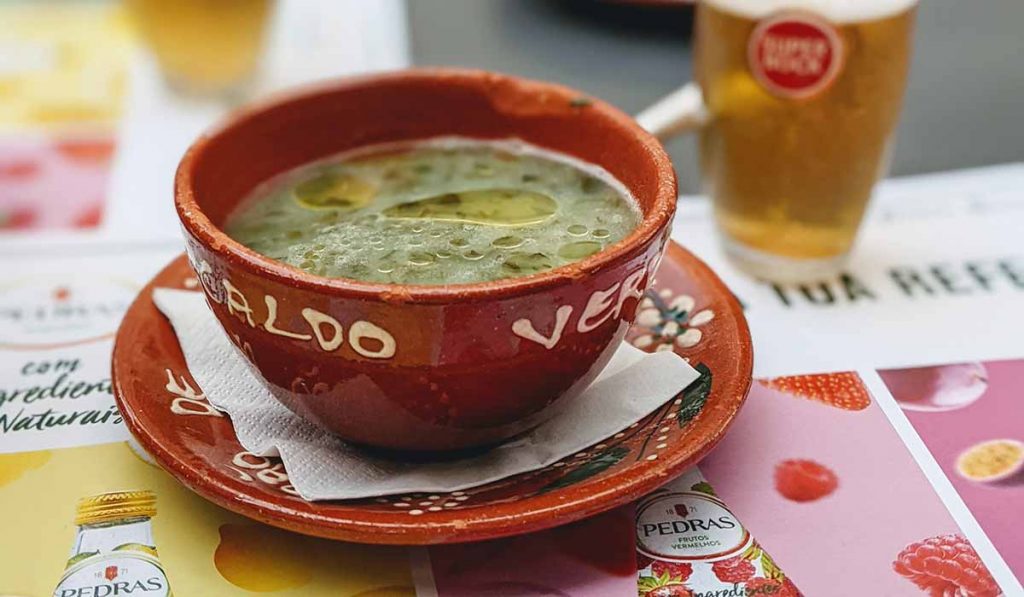
Soup, yes soup, is among the top choice of late-night revellers in Lisbon. Many Portuguese weddings have bifanas and caldo verde for ceia (midnight meal), and you can source a bowl of this cabbage and potato soup (with a piece of chouriço floating in it) from A Merendeira until 7am daily, along with a Pão com chouriço.
Where to eat caldo verde: Late-night find it at A Merendeira, or on the menu at tascas for lunch or dinner.
Expect to pay €2-3
Read next: Sardines & pimba: Your guide to Lisbon’s Santo António Festival
Chamuças (samosas)
“You have to try the traditional Portuguese chamuças!” exclaimed my Portuguese cousin when we’d first arrived here. “You mean… this samosa, a spiced Indian snack filled with minced curry chicken?” I replied, skeptical.
I see both sides to this story. Portugal had colony in Goa for many centuries, so every Portuguese person has grown up with chamuças readily available at traditional cafes and tascas.
This snack definitely has its heart and core in India, but it’s also a staple here and you’ll find chicken-stuffed chamuças throughout the country. Around midnight or 1am in Bairro Alto, Pink Street and other nightlife hotspots, undercover vendors will pop up with boxes filled with still-warm pão com chouriço and chamuças.
Where to eat chamuças: on the street, at tascas, or in Indian restaurants.
Expect to pay €1-2
Roulottes (food trucks)
The funny thing about food trucks in Portugal? Despite having wheels, the food trucks don’t change location. Some are permanently parked, while others will pop up in the evenings to serve late-night party people on their return home.
Often they’ll sell really basic hamburgers for less than €5, hotdogs, bifanas and maybe kebabs. I know of late-night vans parked at Quiosque de Santos, outside É Prà Poncha, and Roulotte Pitéu da Rua at Alcântara-Mar.
>>> Love a street food tour? >>> Taste the traditions of Lisbon with Devour’s half-day street food tour, or go seriously deep into Lisbon’s food scene with Culinary Backstreets’ all-day food tours, or Oh! My Cod’s original four-hour jaunt that tastes 17 different items!
Find accommodation in Lisbon
That’s my wrap of the best street food in Lisbon. Find a new favourite spot? Did I miss your favourite street snack? Leave a comment….
Keep reading about food in Lisbon…
- Where to eat in Lisbon: 26 best restaurants and tascas
- The Best Food Tours & Experiences in Lisbon
- Best places to eat octopus in Lisbon
- The best pastéis de nata in Lisbon
- 11 best viewpoints in Lisbon
- The best cooking classes in Lisbon
- The best pastel de nata cooking classes
- Lisbon’s best day trip: Sintra 1 or 2-Day Itinerary
- Where to eat in Belém: Local’s guide to the best restaurants, snacks and bars

